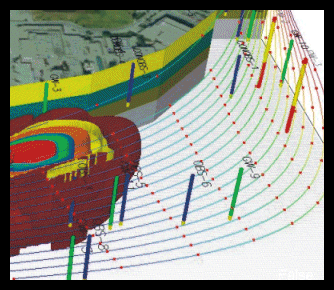
 |
|
|
|
|||||||||||||||||||||||||
|
|
| Texture Class | n |
| Clay | 1.25 |
| Loam | 1.47 |
| Sand | 3.17 |
| Silt | 1.67 |
From USDA Rosetta Model list of class average hydraulic parameters (http://www.ars.usda.gov/Services/docs.htm?docid=8955)
A calculator for Brooks and Corey's relative permeability term is given below.
Brooks and Corey Relative Permeability Calculator
Өm:
Өr:
porosity:
n:
kr: atm m3/mol
Example Calculation
A fine textured soil has a saturation of 0.25, a residual saturation of 0.1 and a porosity of 0.3. Using a van Genuchten n value of 1.2, what is the residual permeability?
Calculate Өm-Өr: 0.25-0.1 = 0.15
Calculate ӨT-Өr: 0.3-0.1 = 0.2
Relative permeability = 0.751.2 = 0.71
There are many software products available for determining unsaturated flow. One of these programs is the Visual MODFLOW addition, MODFLOW-SURFACT.
References
Tindall, J.A. and Kunkel, J.R. (1999). Unsaturated Zone Hydrology for Scientists and Engineers. Published by Prentice-Hall Inc., New Jersey.
Warrick, A.W. (2003). Soil Water Dynamics. Published by Oxford University Press, New York.
Visual MODFLOW with MODFLOW-SURFACT
Visual MODFLOW is a widely used groundwater modelling program, with extensive capabilities. Some of these capabilities are not available through the traditional MODFLOW environment, but have been made available through add-on programs. Some add-ons include MIKE 11, a surface water modeling package, WinPEST, a parameter estimation package, and MODFLOW-SURFACT, a variably saturated groundwater flow package. It is this program, MODFLOW-SURFACT, that will be the topic of this month's newsletter.
MODFLOW-SURFACT is a robust 3D finite-difference flow and transport program that includes several improvements over the public domain version of MODFLOW such as the ability to handle complex variably-saturated flow and transport. Other capabilities include:
|
|
Unsaturated vapor flow |
|
|
Adaptive time-stepping |
|
|
Solver incorporates Newton-Raphson linearization |
|
|
Multi-phase, multi-component solute transport |
|
|
Advective-dispersive transport with retardation |
|
|
Biochemical degradation |
|
|
many more! |
Examples of when you would use MODFLOW-SURFACT include scenarios where you have multiple water tables or perched aquifers, steep flow gradients, infiltration through the vadose zone, and vapor flow through the unsaturated zone.
For more info click here:
Visual MODFLOW
For demo download
click here:
Demo Download
To purchase click here:
Order
Online
![]()

Visual MODFLOW
Detailed Info
Demo Download
Purchase

Brought to you by: Environmental Software Online, LLC |